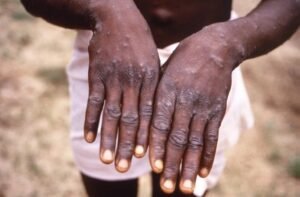Ibrexafungerp: A novel antifungal
Ibrexafungerp, an enfumafungin derivative, belongs to a new family called triterpenoid antifungals.
This is a new class called “-fungerp”.
This antifungal class inhibits glucan synthetase required for fungal cell wall synthesis. One of the major antifungal class echinocandins also acts by this mechanism and has been used since 2001. Echinocandins, however, have poor bioavailability and are only available as parenteral preparation. Echinocandins are highly protein-bound and have a large molecular size. The penetration of echinocandins to the CSF and urine is limited.
Fungerps are designed to overcome some of these limitations.

Mechanism of action
- Ibrexafungerp is a β-1,3-glucan synthase inhibitor similar to echinocandins (like caspofungin).
- β-1,3-glucan synthase is necessary to synthesise β-1,3-glucan, which is an essential component of the fungal cell wall.
- Inhibition of β-1,3-glucan synthase leads to the loss of cell wall integrity, making it more permeable and eventually death by cell lysis.
Echinocandins bind to the FKS1 domain of β-1,3-glucan synthase. Enfumafungin and its derivatives bind at an alternate site. There might be a limited overlap of the binding site.
Mechanism of resistance
Ibrexafungerp has activity against many echinocandin resistance strains (due to FKS gene mutation). The target site for echinocandin and Ibrexafungerp only overlap by a limited amount – some cross-resistance may occur.
Some mutations in the FKS gene may increase the MIC, e.g. F625del in FKS1/ F659del, W715L and A1390D in FKS2.
Spectrum
The spectrum of the glucan synthetase inhibitors is determined by the amount of β-1,3-glucan present in the cell wall of the fungal class. Candida, Aspergillus and Saccharomyces tend to have a high amount of β-1,3-glucan in their cell wall and are susceptible. Fungal classes with low amounts of β-1,3-glucan Mucorales, Fusarium spp. and Scedosporium spp are not.
Yeast
| Genus | Activity |
| Candia | Good activity against Candida species, including many echinocandin resistant strains. It has activity against Candida auris. Limited cross-resistance could be seen in some resistant strains due to FKS mutation. |
| Rhodotorulla | Variable |
| Trichosporon spp. | Variable |
Moulds –
| Genus | Activity |
| Aspergillus | Good activity, fungistatic |
| Paecilomyces | active |
| Penicillium | active |
| Scytalidium | active |
| Alternaria | active |
| Cladosporium | active |
| Scopulariopsis | variable/some activity |
| Scedosporium apiospermum, Lomentospora (Scedosporium) prolificans | variable/some activity |
| Mucorales | no/limited acitivity |
| Fusarium | no/limited acitivity |
| Lichtheimia | no/limited acitivity |
| Acremonium | no/limited acitivity |
Dermatophytes – good activity
PK/PD
- Oral bioavailability of 35% – 50%. Taking the drug with a high-fat meal increases bioavailability.
- High protein binding – 99% or more. Lipophilic.
- Half-life of 7–9 h, and mean terminal half-life of approximately 20 to 30 h.
- Ibrexafungerp has wide tissue distribution with high tissue penetration. The tissue concentration in the spleen, liver, kidney, lungs, bone marrow, skin and vaginal tissue is several times higher (9-54 times) than in the blood. Penetration to CNS is minimal.
- Mostly excreted via faeces
- ibrexafungerp is a CYP3A4 substrate and reversible inhibitor of CYP2C8 and CYP3A4, but it likely has low potential to cause CYP interaction at the therapeutic drug level.
Adverse effect
Gastrointestinal adverse effects – diarrhoea, abdominal pain, nausea, vomiting, and flatulence
Trials
Many trials are registered or ongoing- see here:
https://clinicaltrials.gov/ct2/results?cond=&term=ibrexafungerp&cntry=&state=&city=&dist=
CANDLE-304, VANISH-303 and VANISH-306 – oral ibrexafungerp in patients with recurrent vulvovaginal candidiasis,
SCYNERGIA – coadministration of ibrexafungerp with voriconazole in patients with invasive pulmonary aspergillosis,
CARES – emergency use treatment for patients with candidiasis, including C. auris candidemia,
FURI – fungal diseases refractory to standard treatment
Ref
https://www.mdpi.com/2309-608X/7/3/163/pdf
https://www.frontiersin.org/articles/10.3389/fcimb.2021.642358/full

